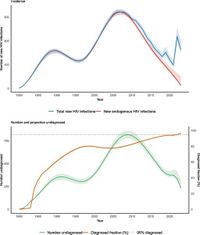In the ongoing global fight against HIV, two very different places—Bethlehem, Pennsylvania and Norway—are showing the world what progress looks like. Both are using innovation, data, and an unwavering commitment to public health to push the boundaries of what’s possible in HIV prevention, diagnosis, and care.
At the heart of Bethlehem, a city perhaps better known for its steel-making past, OraSure Technologies has quietly become a global leader in diagnostic testing. According to WPVI, this Lehigh Valley company developed OraQuick, the first saliva-based, at-home HIV test approved for over-the-counter use in the United States. It’s a small device with a massive impact: “It was the first HIV test to get over-the-counter approval, and it’s saliva-based, which means you don’t have to break a finger or take blood in order to get the results,” said Zach Wert, OraSure’s senior vice president of operations. That’s a game-changer for anyone who’s ever been anxious about a blood test or worried about privacy.
OraSure’s 139,000-square-foot facility is a hive of activity, producing millions of diagnostic tests each year. While OraQuick remains the only oral fluid rapid HIV test of its kind approved for adult use in the U.S., the company’s reach extends far beyond HIV. During the COVID-19 pandemic, OraSure ramped up production dramatically to meet an urgent global demand for rapid testing. Wert described the effort as “a global push to provide COVID tests to meet public health need.” The company’s roots go back to a handful of Lehigh University graduates with a vision for accessible diagnostics—a vision that’s now saving lives around the world.
“Our employees are really proud of what we do right here in Pennsylvania—whether it’s the tests that we create, the people that we serve, the customers that we serve, the health that we help people find their diagnosis or from the tests that we make right here,” Wert told WPVI. The pride is palpable, and it’s not hard to see why: OraSure’s work is a testament to how local innovation can have a global impact.
Half a world away, Norway is making headlines of its own—with data, rather than devices. A 2025 study published in BMC Infectious Diseases used linked national registry data and the European Centre for Disease Prevention and Control (ECDC) HIV modelling tool to estimate the state of HIV in Norway up to the end of 2023. The results? Remarkable progress, but also a reminder that the fight isn’t over yet.
The study analyzed 7,185 new HIV diagnoses up to 2023, with a striking 59% among migrants. But here’s the twist: 86% of new infections among migrants were acquired before they even arrived in Norway. That’s a crucial distinction, as it reframes the narrative from one of domestic transmission to one of global migration and health equity. When pre-migration infections are excluded, only about 13 new HIV infections occurred in Norway in 2023—a number that would have been unthinkable just a few decades ago.
The number of undiagnosed people living with HIV (PLHIV) in Norway stood at an estimated 234 by the end of 2023. That might sound like a lot, but it’s a dramatic decrease from previous years. Most critically, the proportion of diagnosed PLHIV reached 96.5%, surpassing the global target of 95% set by the World Health Organization. Norway has thus joined an elite club of countries that have met this ambitious benchmark.
But the numbers also reveal where more work is needed. The diagnosed fraction was slightly below the 95% target among Norwegian-born heterosexual transmissions (92.6%) and migrant men who have sex with men (MSM) (92.2%). These gaps highlight the importance of tailored interventions and outreach to communities that might be missing out on testing or treatment opportunities.
Norway’s public health approach is multi-pronged and inclusive. Testing and health services for HIV are free of charge, regardless of legal status—a powerful statement about the right to healthcare. Since 2016, everyone diagnosed with HIV is offered antiretroviral treatment, and pre-exposure prophylaxis (PrEP) has been publicly funded since 2017. By 2024, the number of PrEP users in Norway reached 3,500, one of the highest rates per capita in Europe. That’s not all: needle and syringe programs for people who inject drugs have been available since 1987, and opioid agonist therapy since 1998, both exceeding global targets for harm reduction.
The study’s author, using data from 1987 to 2023, emphasized the importance of comprehensive surveillance and the value of linking multiple data sources. This approach allows for a more accurate picture, especially in countries where migration plays a major role in the epidemiology of HIV. The arrival of 72,000 refugees from Ukraine in 2022 and 2023, for example, contributed to a temporary uptick in new diagnoses—a reminder that public health doesn’t exist in a vacuum.
Norway’s achievement is not just about numbers, but about systems and social values. “Existing measures should be maintained and strengthened to further reduce the undiagnosed population and prevent transmission,” the study concluded. The country has shown that a combination of free, accessible testing, robust treatment programs, and harm reduction can drive down HIV incidence and improve outcomes for everyone.
Yet, even with these successes, challenges persist. Late diagnosis remains a concern, with 30-40% of new cases diagnosed late, and over 50% among those infected through heterosexual sex. The European goal of less than 20% diagnosed late by 2025 remains elusive. Stigma and discrimination, while less visible in the data, continue to be real barriers for many living with or at risk of HIV.
What do these stories—one of American innovation, the other of Norwegian public health—teach us? First, that progress against HIV is possible, but it requires both technological advances and social commitment. OraSure’s OraQuick test has made it easier and less intimidating for people to learn their HIV status in the privacy of their own homes. Norway’s data-driven approach ensures that resources are targeted where they’re needed most, and that no one falls through the cracks.
Second, that the global nature of HIV means countries must look beyond their borders. Migration, conflict, and inequality all shape the epidemic in ways that no single nation can control. By recognizing and addressing these realities—whether through innovative diagnostics or inclusive health policies—countries can make significant strides toward ending HIV as a public health threat.
As the world edges closer to the 2030 target of ending AIDS as a public health threat, the examples of Bethlehem and Norway offer hope and a roadmap. The work isn’t finished, but it’s clear that with the right tools, data, and determination, remarkable progress is within reach.




